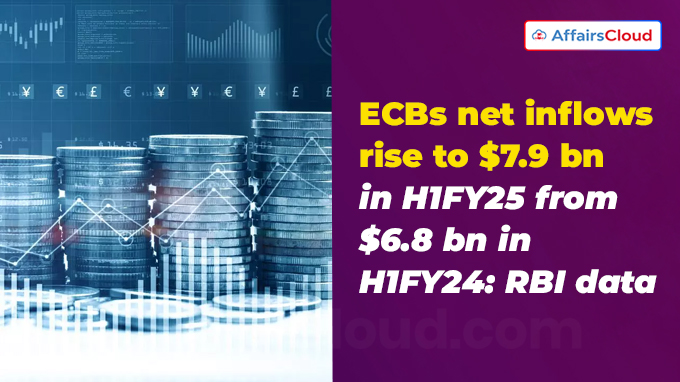 According to the Reserve Bank of India (RBI)’ November monthly bulletin data released on 20th November 2024, the net inflows through External Commercial Borrowings (ECBs) has increased from USD 6.8 billion in 1st Half (H1: April-September) of Financial Year 2023-24 (FY24) to USD 7.9 billion in H1FY25.
According to the Reserve Bank of India (RBI)’ November monthly bulletin data released on 20th November 2024, the net inflows through External Commercial Borrowings (ECBs) has increased from USD 6.8 billion in 1st Half (H1: April-September) of Financial Year 2023-24 (FY24) to USD 7.9 billion in H1FY25.
- As per the “State of Economy” report in RBI’s November bulletin, nearly 50% of the new ECBs registered during H1FY25 were intended for capital expenditure including on-lending and sub-lending for capex.
Key Findings related to ECBs:
i.Decline in ECBS for Capital Goods – ECBs for import/local sourcing of capital goods dropped to USD 1.3 billion in H1FY25 from 9.4 billion in H1FY24.
- The modernization/new project and infrastructure development related ECB decreased to USD 5.6 billion from USD 7.7 billion in H1FY24 .
ii.The ECBs for working capital and general corporate increases from USD 4.0 billion (in H1FY24) to USD 10.2 billion (in H1FY25).
iii. New ECB loan registrations and disbursements were USD 14.3 billion and USD 12.8 billion in Q2FY25, respectively, which were higher compared to the previous quarter s(Q1FY25) and Q2FY24.
iv.ECB Proposals by Indian Corporates in September 2024: In September 2024, the Indian corporates, including Non-Banking Financial Companies (NBFCs) had filed ECB proposals with the RBI to raise USD 4.8 billion, of which USD 3.77 billion will be raised through automatic route and USD 1.06 million through the approval route.
v.The report noted that the recent easing of global benchmark interest rates such as the Secured Overnight Financing Rate (SOFR) resulted in decrease in the overall cost of ECBs raised during September 2024.
- The Weighted Average Interest Margins (WAIM) over the benchmark rates during the H1FY25 was 5 basis points (bps) higher compared during H1FY24.
vi.Over 75% (3/4th )of registered ECBs during H1FY25 were effectively hedged in terms of explicit hedging, , reducing sensitivity to interest and exchange rate fluctuations.
Outward Remittances under LRS Drop by 14.88% in H1FY25:
According to the RBI’s data, outward remittances under the RBI’s Liberalised Remittance Scheme (LRS) declined by 14.88% Year-on-Year (Y-o-Y) during the H1FY25, mainly attributed by decrease across major segments.
- Remittances for the maintenance of close relatives decreased significantly by 37.17% Y-o-Y to USD 1.92 billion from USD 3.05 billion.
Note: According to the data released in RBI’s monthly bulletin for September 2024, outward remittances under LRS decreased from USD 18.34 billion (in H1FY24) to USD 15.61 billion (in H1FY25).
Highlights of Decline in Outward Remittances Under LRS
- Funds Allocations on Education has also decreased by 12.83% Y-o-Y, from USD 1.84 billion (in H1FY24) to USD 1.60 billion (H1FY25).
- International travel ,constituting approximately 57% decreased of about 1% Y-o-Y to USD 9.0 billion (in H1FY25), compared to USD 9.30 billion (in H1FY24).
- Immovable property declined by 9.38%, from USD 150 million to USD 136 million.
- Investments in equity and debt markets decreased by 19.09% Y-o-Y to USD 699.26 million from USD 864.32 million.
- iv.The “Gift” segment decreased of 31% Y-o-Y, from USD 22.61 billion to USD 15.53 billion.
- “Deposits” segment decreased by 55% Y-o-Y to USD 294.9 million from USD 660 million.
- September 2024 Figures of Outward remittances
- Total remittances stood at USD 2.76 billion (vs. USD 3.50 billion in September 2023).
a.Maintenance for relatives dropped 50% YoY to USD 281.24 million.
b.Gift segment declined 63.73% YoY to USD 43 million.
About LRS Scheme:
Introduced in 2004, the Liberalised Remittance Scheme (LRS) allows resident individuals, including minors, to remit up to USD 250,000 annually for permissible current or capital account transactions,with the initial cap of USD 25,000, the limit has been revised periodically to suit economic conditions.
Gross FDI in India Rises 25.7% in H1FY25, Net FDI moderates to USD 3.6 billion
As per the RBI’s data, Gross Foreign Direct Investment (FDI) in India has increased by 25.7% Y-o-Y, from USD 33.5 billion (in H1FY24) to USD 42.1 billion (H1FY25).
- In contrast to it, net FDI (calculated as inflows excluding outflows) has moderated to USD 3.6 billion during H1FY25 from USD 3.9 billion in the in H1FY24. The decline was mainly due to an increase in repatriation and outward FDI.
Key Findings:
i.Repatriation or disinvestment by investors who had made direct investments in India has increased from USD 23.1 billion (in H1FY24) to USD 27.8 billion (in H1FY25) while outward FDI during H1FY25 increased to USD 10.7 billion from USD 6.5 billion in H1FY24.
ii.FDI Inflows by sector – Manufacturing, financial service, electricity and other energy sectors, and communication services together accounted for about 2/3rd of gross FDI inflows.
- Top FDI Sources: Singapore, Mauritius, the Netherlands, the United Arab Emirates (UAE), and the United States of America (USA) were the sources for nearly 75% of the FDI inflows.
iii.India has emerged as a leader in Artificial Intelligence (AI),
- India has ranked among the top 6 global economies in terms of investments in generative AI start-ups since 2023.
- Also, India is listed among top 10 countries in combined private AI investments between 2013 and 2023.
iv.NRI deposit inflows surged nearly doubled, reaching USD10.19 billion in H1FY25, up from USD5.41 billion in H1FY24. This increase was largely driven by foreign currency non-resident (FCNR) deposits, which increased from USD1.92 billion to USD5.34 billion.
- As of September 2024, total NRI deposits stood at USD161.62 billion.The NRI deposit schemes include FCNR deposits, non-resident external (NRE) deposits, and non-resident ordinary (NRO) deposits.
Other Key Points:
i.As per RBI data, headline inflation as measured by Y-o-Y changes in the all-India CPI, has increased 70 basis points (bps), from 5.5% (in September 2024) to 6.2% (in October 2024) while food inflation increased Y-o-Y to 9.7% in October 2024, compared to 8.4% in September 2024.
ii.The Indian Rupee (INR) appreciated by 1.8% month-on-month (m-o-m) in October in terms of the 40-currency Real Effective Exchange Rate (REER). This increase was mainly attributed by the nominal appreciation of the rupee alongside positive inflation.
- REER, which measures the value of the INR against a basket of other currencies has decreased marginally from 105.44 (in August 2024) to 105.15 (in September 2024).
- As per the report, Since the early 2000s, REER has appreciated on average by 1% per year, while the Nominal Effective Exchange Rate (NEER) has depreciated by nearly 2% per year.
iii.As on 8th November 2024, India’s Foreign Exchange Reserves (FER) decreased to UD 675.7 billion from USD 705.8 billion recorded at end- September 2024.
About Reserve Bank of India(RBI):
Governor– Shaktikanta Das (25th Governor of RBI)
Headquarters- Mumbai, Maharashtra
Established– 1 April, 1935




